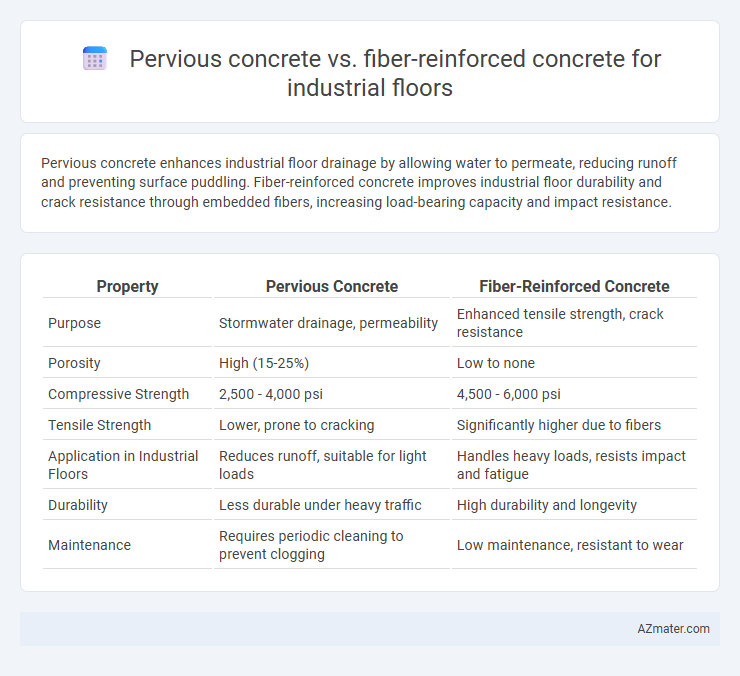Pervious concrete enhances industrial floor drainage by allowing water to permeate, reducing runoff and preventing surface puddling. Fiber-reinforced concrete improves industrial floor durability and crack resistance through embedded fibers, increasing load-bearing capacity and impact resistance.
Table of Comparison
| Property | Pervious Concrete | Fiber-Reinforced Concrete |
|---|---|---|
| Purpose | Stormwater drainage, permeability | Enhanced tensile strength, crack resistance |
| Porosity | High (15-25%) | Low to none |
| Compressive Strength | 2,500 - 4,000 psi | 4,500 - 6,000 psi |
| Tensile Strength | Lower, prone to cracking | Significantly higher due to fibers |
| Application in Industrial Floors | Reduces runoff, suitable for light loads | Handles heavy loads, resists impact and fatigue |
| Durability | Less durable under heavy traffic | High durability and longevity |
| Maintenance | Requires periodic cleaning to prevent clogging | Low maintenance, resistant to wear |
Introduction to Industrial Flooring Solutions
Industrial flooring solutions prioritize durability, load-bearing capacity, and safety, making pervious concrete and fiber-reinforced concrete pivotal choices. Pervious concrete excels in stormwater management by allowing water permeability, reducing runoff and enhancing sustainability in industrial environments. Fiber-reinforced concrete offers superior tensile strength and crack resistance, ensuring long-lasting performance under heavy loads and mechanical stress typical in industrial floors.
What is Pervious Concrete?
Pervious concrete is a specialized concrete mix designed to allow water to pass through its porous structure, reducing runoff and improving groundwater recharge, making it ideal for sustainable industrial flooring. It typically consists of coarse aggregates, cement, water, and little or no fine aggregates, creating interconnected voids that facilitate drainage. Unlike fiber-reinforced concrete, which enhances tensile strength and durability with synthetic or steel fibers, pervious concrete prioritizes permeability and environmental benefits for industrial floor applications.
What is Fiber-Reinforced Concrete?
Fiber-reinforced concrete (FRC) is a composite material that incorporates fibrous materials such as steel, glass, synthetic, or natural fibers to enhance its mechanical properties, including tensile strength, toughness, and crack resistance. In industrial floor applications, FRC improves load-bearing capacity and durability under heavy machinery and dynamic loads compared to pervious concrete, which primarily focuses on permeability and drainage. The integration of fibers in concrete reduces shrinkage and abrasion, making it a preferred choice for high-stress, industrial environments requiring long-term performance and minimal maintenance.
Key Material Properties Comparison
Pervious concrete exhibits high porosity and permeability, allowing rapid water drainage, which reduces surface runoff and prevents flooding in industrial floors. Fiber-reinforced concrete demonstrates superior tensile strength and crack resistance due to the incorporation of synthetic or steel fibers, enhancing durability under heavy industrial loads. While pervious concrete prioritizes permeability and environmental benefits, fiber-reinforced concrete excels in mechanical performance and longevity for demanding industrial floor applications.
Load-Bearing Capacity and Performance
Pervious concrete offers superior drainage and reduces surface runoff but generally has lower load-bearing capacity compared to fiber-reinforced concrete, which enhances tensile strength and impact resistance essential for industrial floors under heavy loads. Fiber-reinforced concrete incorporates synthetic or steel fibers that improve crack resistance and overall durability, making it more suitable for high-traffic industrial environments. The choice between these materials depends on balancing permeability requirements with structural performance demands specific to the industrial floor application.
Durability and Longevity Factors
Pervious concrete offers excellent drainage properties but generally has lower compressive strength and durability compared to fiber-reinforced concrete, making it less suitable for high-load industrial floors. Fiber-reinforced concrete enhances tensile strength, crack resistance, and overall toughness, significantly improving durability and extending the lifespan of industrial flooring under heavy traffic and dynamic loads. The inclusion of synthetic or steel fibers mitigates shrinkage and impact damage, ensuring greater longevity and reduced maintenance costs in industrial environments.
Installation Process Differences
Pervious concrete installation for industrial floors requires precise layering and controlled compaction to ensure adequate porosity and drainage, often involving special curing techniques to maintain void structure. Fiber-reinforced concrete installation focuses on uniform fiber distribution throughout the mix, reducing cracking and improving tensile strength, with standard curing methods similar to conventional concrete. The key difference lies in pervious concrete's need for careful void preservation versus fiber-reinforced concrete's emphasis on fiber integration during mixing and placement.
Maintenance Requirements and Costs
Pervious concrete for industrial floors requires frequent cleaning to prevent clogging and maintain permeability, leading to higher ongoing maintenance costs compared to fiber-reinforced concrete. Fiber-reinforced concrete offers enhanced durability and reduced cracking, resulting in lower repair expenses and longer service life with minimal upkeep. Overall, fiber-reinforced concrete provides a cost-effective solution with less intensive maintenance demands in industrial floor applications.
Environmental Impact and Sustainability
Pervious concrete significantly enhances environmental sustainability by enabling natural groundwater recharge and reducing stormwater runoff, which mitigates urban flooding and decreases the need for complex drainage systems in industrial floors. Fiber-reinforced concrete improves durability and prolongs the lifespan of industrial floors, reducing the frequency of repairs and material consumption, thereby lowering the overall environmental footprint. Both materials contribute to sustainable construction, with pervious concrete focusing on water management benefits and fiber-reinforced concrete emphasizing strength and longevity for industrial applications.
Choosing the Best Concrete Option for Industrial Floors
Pervious concrete offers superior drainage capabilities, making it ideal for industrial floors requiring efficient water management to prevent pooling and maintain safety. Fiber-reinforced concrete enhances structural integrity and resistance to cracking under heavy loads, which is essential for supporting industrial machinery and frequent traffic. Selecting the best concrete option depends on prioritizing either permeability and environmental sustainability with pervious concrete or durability and load-bearing strength with fiber-reinforced concrete.

Infographic: Pervious concrete vs Fiber-reinforced concrete for Industrial floor
 azmater.com
azmater.com